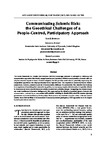Communicating Seismic Risk: the Geoethical Challenges of a People-Centred, Participatory Approach
| dc.contributor.author | Stewart, Iain | |
| dc.contributor.author | Ickert, J | |
| dc.contributor.author | Lacassin, R | |
| dc.date.accessioned | 2018-02-26T19:38:50Z | |
| dc.date.available | 2018-02-26T19:38:50Z | |
| dc.date.issued | 2017-12-01 | |
| dc.identifier.issn | 1593-5213 | |
| dc.identifier.issn | 2037-416X | |
| dc.identifier.uri | http://hdl.handle.net/10026.1/10859 | |
| dc.description.abstract |
The Sendai Framework for Disaster Risk Reduction (SFDRR) encourages scientists to participate in bottom-up risk communication approaches that directly engage hazard-prone populations. Effective communication of seismic risks not only has economic impacts in terms of hazard mitigation but also provides social value in potentially empowering the marginalized populations that disproportionately live in high-risk areas. This emphasis on community-focused disaster preparedness, however, presents a novel set of communication challenges for geoscientists. Few scientists have training in or experience of translating their science for lay publics, and conveying complex risk information is especially difficult in circumstances where scientific issues are socially contested and politically charged. Recognising that disaster threats can create troublesome information battlegrounds, this paper explores the ethical and practical aspects of seismic risk communication, motivated by an early-career earth scientists’ workshop in Istanbul that voiced the concerns of young geoscientists confronted firsthand by at-risk publics. Those concerns form the basis of a wider review of the risk communication issues that are likely to be encountered if community-centred participatory DRR approaches are to be adopted by earthquake science researchers. | |
| dc.language.iso | en | |
| dc.publisher | Istituto Nazionale di Geofisica e Vulcanologia (INGV) | |
| dc.title | Communicating Seismic Risk: the Geoethical Challenges of a People-Centred, Participatory Approach | |
| dc.type | journal-article | |
| plymouth.author-url | https://www.webofscience.com/api/gateway?GWVersion=2&SrcApp=PARTNER_APP&SrcAuth=LinksAMR&KeyUT=WOS:000468732000010&DestLinkType=FullRecord&DestApp=ALL_WOS&UsrCustomerID=11bb513d99f797142bcfeffcc58ea008 | |
| plymouth.volume | 60 | |
| plymouth.publication-status | Published | |
| plymouth.journal | Annals of Geophysics | |
| dc.identifier.doi | 10.4401/ag-7593 | |
| plymouth.organisational-group | /Plymouth | |
| plymouth.organisational-group | /Plymouth/Faculty of Science and Engineering | |
| plymouth.organisational-group | /Plymouth/Research Groups | |
| plymouth.organisational-group | /Plymouth/Research Groups/Marine Institute | |
| plymouth.organisational-group | /Plymouth/Users by role | |
| plymouth.organisational-group | /Plymouth/Users by role/Researchers in ResearchFish submission | |
| dcterms.dateAccepted | 2017-11-06 | |
| dc.identifier.eissn | 2037-416X | |
| dc.rights.embargoperiod | Not known | |
| rioxxterms.version | Version of Record | |
| rioxxterms.versionofrecord | 10.4401/ag-7593 | |
| rioxxterms.licenseref.uri | http://www.rioxx.net/licenses/all-rights-reserved | |
| rioxxterms.licenseref.startdate | 2017-12-01 | |
| rioxxterms.type | Journal Article/Review |


